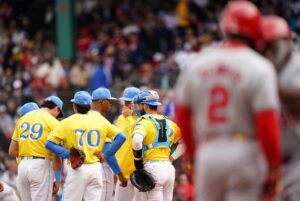The idea of an “opener” is to have a relief pitcher face the top of the lineup in the first inning. Stats suggest that if you are losing after one inning your chance of winning is approximately 30%. Furthermore, more runs are scored in the first inning than any other throughout the game. So a team, it would seem, would be wise to put a shutdown reliever in to start and face the top hitters right away. In turn, the “continuer” would be a traditional starter who could pitch from the second inning until the sixth or seventh.
The Advantage
The pitcher who comes into the game in the second inning would start by facing, ideally, the cleanup hitter or the fifth batter. This would help since he would likely only face the top of the lineup twice. Now that teams are putting their best hitter in the two-hole, i.e. Mike Trout and Aaron Judge, it would seem to make even more sense to employ an opener. The Tampa Bay Rays have used Sergio Romo in this role five times so far with mixed results. Aside from a three-run first inning against the Baltimore Orioles, Romo has only allowed one run over 4.1 IP. Admittedly it is a small sample size and Romo isn’t exactly Aroldis Chapman so the jury is still out.
The Problems
Baseball players, particularly pitchers, are creatures of habit. There may be a few pitchers in the league that don’t mind just getting guys out regardless of the situation. Many seem to like a more defined role. Starting pitchers also may feel uncomfortable coming into a game after sitting for a whole inning.
Money is another issue. Pitchers can garner a higher pay in arbitration or even free agency if they are a closer or possibly a top-notch setup man. The players and their agents may see it as a detriment to their earning potential. They may question how an arbitrator or a prospective team would judge their past performance as an opener. If a pitcher thinks he may lose out on millions of dollars in future earnings, he may be averse to accepting the opener role.
While the opener may look like a good idea, rotation and bullpen construction would play a big part in the success of that position. A team with a deep bullpen, possibly with multiple relievers with closing experience, may be more successful especially if the opener was used sparingly. For example, the New York Yankees could conceivably start Chad Green and then follow with Domingo German for five or six innings and follow that up with any combination of David Robertson, Dellin Betances, or Chapman.
Overview
There are certain times where an opener would be warranted. Starters like Max Scherzer and Corey Kluber aren’t going away. Teams also would not think of changing their routine when they have an ace of that caliber. When it comes to the fourth and fifth pitchers spot though, it becomes more of a question. Will the opener become the new darling of statheads and sabermetric geeks across major league baseball? Probably not. Will it eventually be used most of the time by most teams in major league baseball? Probably not. Will teams try it themselves and see if they gain a statistical advantage over their opponents? Yes. Without a doubt.
Main Credit Image: Embed from Getty Images






